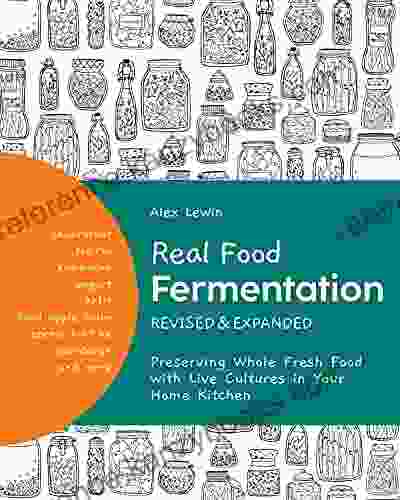Unlock the Secrets of Real Food Fermentation: A Comprehensive Guide to Fermenting at Home

In an era where processed foods dominate our diets, the art of real food fermentation offers a refreshing return to traditional culinary practices. Real food fermentation is the process of converting food into delightfully sour, tangy, and effervescent delicacies through the action of friendly microbes. This ancient technique not only enhances the flavor and nutritional value of food, but also supports gut health and promotes overall well-being.
In this comprehensive guide, we delve into the fascinating world of real food fermentation. You'll discover the countless benefits of fermented foods, explore a wide range of fermentation techniques, and embark on a culinary journey with detailed recipes for a variety of fermented delights. Whether you're a seasoned fermenter or just starting your fermentation adventure, this guide will empower you to create delicious and nutritious fermented foods in the comfort of your own home.
5 out of 5
| Language | : | English |
| File size | : | 19860 KB |
| Text-to-Speech | : | Enabled |
| Screen Reader | : | Supported |
| Enhanced typesetting | : | Enabled |
| Word Wise | : | Enabled |
| Print length | : | 393 pages |
The Power of Fermented Foods
Fermented foods have been a staple in human diets for centuries, providing essential nutrients and supporting overall health. The fermentation process enhances the food's vitamin and mineral content, while also creating beneficial probiotics. These probiotics are live microorganisms that support a healthy gut microbiome, which is crucial for immune function, digestion, and overall well-being.
Consuming fermented foods has been linked to numerous health benefits, including:
- Improved digestion and reduced bloating
- Boosted immunity and reduced risk of infections
- Enhanced nutrient absorption and reduced inflammation
- Lowered cholesterol and reduced risk of heart disease
- Improved mood and reduced anxiety
Fermentation Techniques: A Journey of Transformation
The art of fermentation encompasses a diverse array of techniques, each with its own unique characteristics and applications. Let's explore some of the most common fermentation methods:
Lactic Acid Fermentation
Lactic acid fermentation is a versatile technique that can be applied to a wide range of vegetables, fruits, and dairy products. Lactic acid bacteria, the key players in this process, convert the natural sugars in food into lactic acid. This process gives fermented foods their characteristic tangy flavor and preserves them naturally.
Alcoholic Fermentation
Alcoholic fermentation is the process by which yeast converts sugars into alcohol and carbon dioxide. This technique is commonly used to produce alcoholic beverages such as beer, wine, and cider. However, alcoholic fermentation can also be applied to create fermented foods such as sourdough bread.
Acetic Acid Fermentation
Acetic acid fermentation is responsible for the distinctive sour flavor of vinegar. Acetic acid bacteria convert the alcohol produced during alcoholic fermentation into acetic acid. This process is used to create a variety of vinegars, including apple cider vinegar, kombucha, and balsamic vinegar.
A Culinary Odyssey: Fermented Delights for Every Palate
The world of fermented foods is a culinary paradise, offering a symphony of flavors and textures. From tangy sauerkraut to effervescent kombucha, there's a fermented food to satisfy every palate.
Fermented Vegetables
Fermented vegetables are a healthy and flavorful addition to any meal. They can be made with a variety of vegetables, including cabbage, carrots, cucumbers, and beets. Fermented vegetables are a rich source of probiotics and can be enjoyed as a side dish, added to salads, or used in sandwiches and wraps.
Fermented Fruits
Fermented fruits add a unique tangy sweetness to desserts, smoothies, and sauces. Fruits such as apples, pears, and berries can be fermented to create delicious fruit preserves, chutneys, and syrups.
Fermented Dairy Products
Fermented dairy products have been a staple in many cultures for centuries. Yogurt, kefir, and cheese are all examples of fermented dairy products. These foods are not only delicious, but also provide a rich source of calcium and probiotics.
Fermented Drinks
Fermented drinks offer a refreshing and healthy alternative to sugary sodas and juices. Kombucha, a fermented tea drink, is a popular choice due to its probiotic content and slightly sweet, effervescent flavor. Other fermented drinks include kefir water, ginger beer, and kvass.
Getting Started with Real Food Fermentation: A Step-by-Step Guide
Embarking on your fermentation journey is easy and rewarding. Here's a step-by-step guide to help you get started:
Gather the Necessary Equipment
To begin fermenting, you'll need a few essential pieces of equipment:
- Fermentation jars or containers
- Weights to keep food submerged
- A scale for measuring ingredients
- A pH meter (optional)
Choose the Right Ingredients
The quality of your fermented foods depends on the quality of your ingredients. Choose organic, locally grown produce whenever possible. Fresh, unblemished fruits and vegetables are ideal for fermentation.
Prepare the Ingredients
The preparation method varies depending on the type of fermentation you're ng. For example, vegetables for lactic acid fermentation need to be shredded or sliced, while fruits for alcoholic fermentation need to be crushed or juiced.
Create the Fermentation Environment
The fermentation environment should be cool, dark, and humid. A temperature range between 60-75°F (15-24°C) is optimal for most fermentation processes. You can use a fermentation
5 out of 5
| Language | : | English |
| File size | : | 19860 KB |
| Text-to-Speech | : | Enabled |
| Screen Reader | : | Supported |
| Enhanced typesetting | : | Enabled |
| Word Wise | : | Enabled |
| Print length | : | 393 pages |
Do you want to contribute by writing guest posts on this blog?
Please contact us and send us a resume of previous articles that you have written.
 Book
Book Novel
Novel Page
Page Chapter
Chapter Text
Text Story
Story Genre
Genre Reader
Reader Library
Library Paperback
Paperback E-book
E-book Magazine
Magazine Newspaper
Newspaper Paragraph
Paragraph Sentence
Sentence Bookmark
Bookmark Shelf
Shelf Glossary
Glossary Bibliography
Bibliography Foreword
Foreword Preface
Preface Synopsis
Synopsis Annotation
Annotation Footnote
Footnote Manuscript
Manuscript Scroll
Scroll Codex
Codex Tome
Tome Bestseller
Bestseller Classics
Classics Library card
Library card Narrative
Narrative Biography
Biography Autobiography
Autobiography Memoir
Memoir Reference
Reference Encyclopedia
Encyclopedia Amanda Torres
Amanda Torres Ally Maz
Ally Maz Ali Meeks
Ali Meeks Alice Christensen
Alice Christensen Alicia Britt Chole
Alicia Britt Chole Emily Jacobs
Emily Jacobs Amy Plano
Amy Plano Mardy Grothe
Mardy Grothe Marsha Means
Marsha Means Jean Simpson
Jean Simpson Alison J Kay Phd
Alison J Kay Phd Megan Mcnealy
Megan Mcnealy Jim Rendon
Jim Rendon Allison Kave
Allison Kave Alison T Smith
Alison T Smith Peter Richards
Peter Richards Alexa Fleckenstein
Alexa Fleckenstein Alicia Silverstone
Alicia Silverstone Sylvester Baldwin
Sylvester Baldwin Amanda Chantal Bacon
Amanda Chantal Bacon
Light bulbAdvertise smarter! Our strategic ad space ensures maximum exposure. Reserve your spot today!
 Dean ButlerFollow ·10.3k
Dean ButlerFollow ·10.3k Anton ChekhovFollow ·8.6k
Anton ChekhovFollow ·8.6k Asher BellFollow ·3.8k
Asher BellFollow ·3.8k Jett PowellFollow ·7.6k
Jett PowellFollow ·7.6k Jon ReedFollow ·15.9k
Jon ReedFollow ·15.9k Deacon BellFollow ·2.2k
Deacon BellFollow ·2.2k Craig BlairFollow ·3.2k
Craig BlairFollow ·3.2k Corey GreenFollow ·5.7k
Corey GreenFollow ·5.7k

 Alfred Ross
Alfred RossThe Little Red Book of Running: A Comprehensive Guide to...
Running is one...

 Fabian Mitchell
Fabian MitchellThe Ultimate Step-by-Step Cookbook with 101 Quick and...
Are you looking for a...

 Eric Nelson
Eric Nelson101 Recipes From Azerbaijan And Around The World: A...
Embark on a...

 Troy Simmons
Troy SimmonsTurmeric: The Best Ally of Your Integral Wellness
Embark on a journey...
5 out of 5
| Language | : | English |
| File size | : | 19860 KB |
| Text-to-Speech | : | Enabled |
| Screen Reader | : | Supported |
| Enhanced typesetting | : | Enabled |
| Word Wise | : | Enabled |
| Print length | : | 393 pages |
















